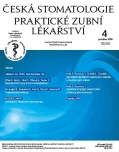Wear of Dental Filling Materials and Possibilities of its Measurement
Authors:
P. Holík 1; Y. Morozova 1; R. Čtvrtlík 2; J. Tomáštík 2
Authors‘ workplace:
Klinika zubního lékařství LF UP a FN, Olomouc
1; Společná laboratoř optiky a fyziky PřF UP, Olomouc, a FZÚ AV ČR
2
Published in:
Česká stomatologie / Praktické zubní lékařství, ročník 118, 2018, 4, s. 95-103
Category:
Review Article
Overview
Background:
Tooth wear is a complex multifactorial phenomenon conditioned by the interaction of biological, mechanical, chemical and tribological factors. The surface of hard dental tissues as filling material replacing enamel and dentine has mechanical load by antagonist (attrition) or another object in the oral cavity such toothbrush, toothpaste, etc. (abrasion). These processes lead to surface defects of hard dental tissues and fillings. The report describes the possible methods of experimental („pin on disc“ method, tooth brushing machine, computer-controlled jaw simulator, material hardness and elastic modulus measurement using nanoindentation, scratch test, etc.) and clinical evaluation (Ryge and Cvar criteria, FDI criteria, profilometry, measurement of computer models by CAD/CAM scanner) wear of dental reconstruction materials.
Conclusion:
Knowledge of the individual properties of the reconstruction materials influencing their wear will help the dentist to choose the appropriate type of material and to properly inform the patient about its reconstruction lifespan.
Keywords:
wear – Ryge and Cvar criteria – FDI criteria – tribology – pin on disk – nanoindentation – scratch test – profilometry
Sources
1. Attin, T., Koidl, U., Buchalla, W., Schaller, H. G., Kielbassa, A. M., Hellwig, E.: Correlation of microhardness and wear in differently eroded bovine dental enamel. Archs. Oral Biol., roč. 42, 1997, č. 3, s. 243–250.
2. Downer, M. C., Azli, N. A., Bedi, R., Moles, D. R., Setchell, D. J.: How long do routine dental restorations last? A systematic review. Br. Dent. J., roč. 187, 1999, č. 8, s. 432–439.
3. Eisenburger, M., Shellis, R. P., Addy, M.: Comparative study of wear of enamel induced by alternating and simultaneous combinations of abrasion and erosion in vitro. Caries Res., roč, 37, 2003, č. 6, s. 450–455.
4. ESD Mechatronik GMBH: Toothbrush simulation. [online] [cit. 5.6.2018]. Dostupné z WWW: http://sdm-gmbh.de/en/products/toothbrush-simulation-zm-38-and-zm-312.html
5. Hacker, C. H., Wagner, W. C., Razzoog, M. E.: An in vitro investigation of the wear of enamel on porcelain and gold in saliva. J. Prosthet. Dent., roč. 75, 1996, č. 1, s. 14–17.
6. Hickel, R., Peschke, A., Tyas, M., Mjör, I., Bayne, S., Peters, M., et al.: FDI World Dental Federation – clinical criteria for the evaluation of direct and indirect restorations. Update and clinical examples. J. Adhes. Dent., roč, 12, 2010, č. 4, s. 259–272.
7. Hrdý, M., Štěpánek, I., Reindl, R., Podlahová, M.: Vrypová zkouška z pohledu hodnocení pomocí obrazové analýzy. In Metal 2003. Ostrava, Tanger, 2003. s. 1–8. ISBN: 80-85988-82-8.
8. ISO, Dental materials – Guidance on testing of wear. [online] [cit. 7. 5. 2018]. Dostupné z WWW: http://www.iso.org/iso/home/search.htm?qt=dental+wear&sort=rel&type=simple&published=on
9. Ježek, V.: Nanoindentace. [online] ÚFE 2011 [cit. 7. 5. 2018]. Dostupné z www: http://physics.muni.cz/~dorian/Jezek_Nanoindentace.pdf
10. Jung, Y., Lee, J.-W., Choi, Y.-J., Ahn, J.-S., Shin, S.-W., Huh, J.-B.: A study on the in-vitro wear of the natural tooth structure by opposing zirconia or dental porcelain. J. Adv. Prosthodont., roč. 2, 2010, č. 3, s. 111–115.
11. Kříž, A.: Tribologická analýza Pin-on-disc. In Metal 2004. Ostrava, Tanger, 2004. s. 1–8. ISBN: 80-85988-95-X.
12. Kurland, N. E., Drira, Z., Yadavalli, V. K.: Measurement of nanomechanical properties of biomolecules using atomic force microscopy. Micron, roč. 43, 2011, č. 2–3, s. 116–128.
13. Lee, A., He, L. H., Lyons, K., Swain, M. V.: Tooth wear and wear investigations in dentistry. J. Oral Rehabil., roč. 39, 2012, č. 3, s. 217–225.
14. Maged, K. E., Woolford, M., Dunne, S.: Quantitative measurement of tooth and ceramic wear: in vivo study. Int. J. Prosthodont., roč. 21, 2008, č. 3, s. 245–252.
15. Mair, L. H., Stolarskij, T. A., Vowles, R. W., Lloyd, C. H.: Wear: mechanism, manifestation and measurement. Report of work. J. Dent., roč. 24, 1996, č. 1–2, s. 141–148.
16. Plášek, J.: Konfokální mikroskop. [online] Vesmír 74, 508, 1995/9 [cit. 5. 6. 2018]. Dostupné z WWW: http://www.vesmir.cz/clanek/konfokalni-mikroskop
17. Raabe, D.: Robomunch – the chewing robot! [online] 2011 [cit. 5. 6. 2018]. Dostupné z WWW: http://www.bristol.ac.uk/dental/news/2011/54.html
18. Stappert, C. F. J., Chitmongkolsuk, S., Silva, N., Att, W., Strub, J. R.: Effect of mouth-motion fatigue and thermal cycling on the marginal accuracy of partial coverage restorations made of various dental materials. Dent. Mater., roč. 24, 2008, č. 9, s. 1248–1257.
19. Yip, K., Smales, R. J., Kaidonis, J. A.: Differential wear of teeth and restorative materials: clinical implications. Int. J. Prosthodont., roč. 17, 2004, č. 3, s. 350–356.
20. Zum Gahr, K.-H.: Classification of wear processes. Microstructure and wear of materials. Elsevier, roč. 10, 1987, s. 80-131.
Labels
Maxillofacial surgery Orthodontics Dental medicineArticle was published in
Czech Dental Journal

2018 Issue 4
Most read in this issue
- All-Ceramic Reconstructions
- Wear of Hard Dental Tissues and Methods of its Evaluation
- Misdiagnosis of Nasopalatine Duct Cyst
- Wear of Dental Filling Materials and Possibilities of its Measurement
